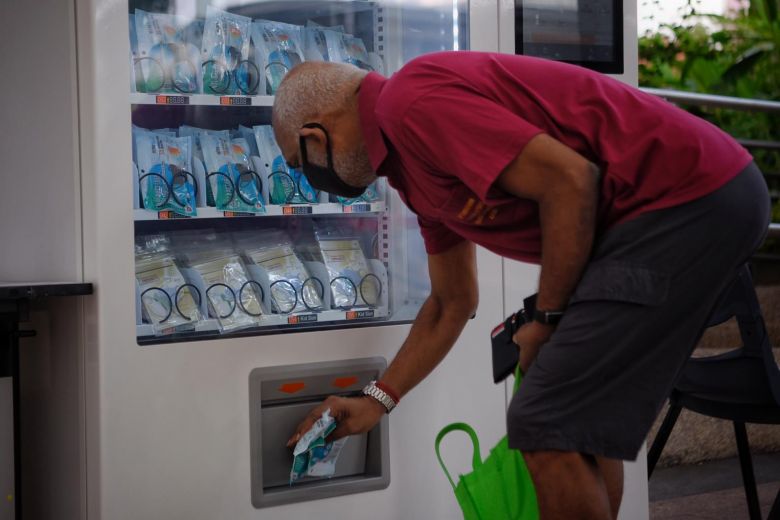
An elderly man collects his reusable mask from a vending machine at Bishan Community Club, on May 26, 2020. ST PHOTO: MARK CHEONG
SINGAPORE — Collecting the new and improved reusable face masks was a breeze for many of the Singapore residents who headed down to community clubs (CCs) and residents’ committee centers (RCs) across the island on Tuesday (May 26) morning.
Thanks to the 400 vending machines placed at all community clubs as part of the third nationwide mask distribution exercise, all it took was the press of an on-screen button and a quick scan of their identification card for residents young and old to get their new masks, which use newer materials that offer better comfort and resistance to droplets.
“It is easier than withdrawing money from your bank,” said a housewife in her 60s who wanted to be known only as Mrs Ng.
“It is just a matter of flashing your identity card to be scanned and the masks come out almost immediately,” said Mrs Ng, who was collecting masks for her family of three at Bishan Community Club.
The latest distribution of new masks kicked off at 10am on Tuesday and will span three weeks until June 14. About six million reusable masks have been prepared for the exercise.
Like the previous two rounds, which lasted about a week each, mask collection counters have been set up at 109 CCs and 661 RCs across Singapore.
Those who want to pick up their masks from CCs or RCs can do so only from 10am to 6pm daily until June 1.
But this time around, residents can also pick the masks up from 24-hour vending machines provided by Temasek Foundation any time during the three-week exercise.
Bishan Community Club and Ang Mo Kio Community Centre each had three of these vending machines.
Staff were stationed at the vending machines to help members of the public. Each machine also has an attached guide detailing three steps for collecting the masks.
Mr Connor Gan, 24, who owns a food and beverage business, was wearing the reusable mask from the previous collection exercise when he went to Bishan Community Club on Tuesday.
He said he preferred the vending machines as they were much more efficient.
“The only thing is that if people don’t understand how to use it then it will be a problem for the rest of the people queuing up. You also can’t use your driver’s license, only your NRIC,” Mr Gan added.
“Hopefully, this mask is better than the one I’m wearing. Breathing and communicating is a problem.”
Ms Santy Halim, 42, a housewife who collected masks for her family on her way home from picking her 12-year-old son up from school, said she had to queue for about 10 minutes during the previous reusable mask distribution in April.
“This time, there is no queue. The staff also helped me just now. It is more convenient,” she said.
Primary 6 pupil Winston Tan went to the community club on his own to collect his mask using the vending machine.
He said: “There is less contact. The person doesn’t have to hand it out to you.”
But for some seniors like Ms Jenny Poon, 72, who made a beeline for the manned collection points set up in the community club’s multi-purpose hall, the vending machines were still a little daunting.
“I did not even give them a look. For older people like us, the machines are not so convenient. I can’t figure out how to use them,” she told ST in Mandarin.
A permanent resident from the Philippines, who wanted to be known only as Carl, told ST that he chose to collect masks for his family at the manned collection points as he was worried that his helper’s work permit would not work well with the vending machines.
“It is easier to have someone do it manually,” the 35-year-old said.
For Madam Maria Bachuk, 38, who was at Ang Mo Kio Community Club with her eight-year-old son Qharil, the new masks also mean she gets to breathe a little easier at work.
The store assistant said she has to wear a mask for about eight to 10 hours every day, and the old reusable masks were uncomfortable.
Trying the new masks on, Madam Maria could immediately tell the difference. She said she felt like she could not breathe properly with the last one. “It had no shape. I cannot use it, not even for one hour.”
Available in adult and child sizes, the new masks are made of at least three layers of material and have a filtration efficiency of at least 95 per cent, even after 30 washes.
The new adult-size masks are produced by textile manufacturer Ghim Li in collaboration with Nanyang Technological University, while the child-size ones are by textile firm Ramatex and the Agency for Science, Technology and Research.
Residents with a valid identification card can collect one reusable mask each.
This includes foreign domestic workers, foreign workers not living in dormitories and international students living in hostels.
The Manpower Ministry will distribute masks to foreign workers living in dormitories.
Priority for child-size masks will be given to those aged 12 and younger.
This means good news for Madam Maria’s son Qharil as well.
She said: “The old one was too big for him because there was only one size, so I had to buy other masks for him. This one is better. It fits his face just nice.”